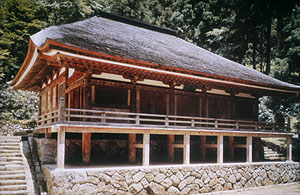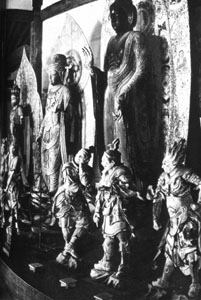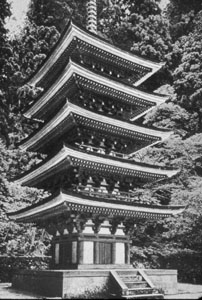Muro-ji |
|
The new type of architecture that began to evolve during this time had little to do with Chinese influences and much to do with the location and environment in which they were constructed. The Muro-ji, used by the Shingon Buddhist sect and completed in the early ninth century, typifies the temples that were constructed during the Early Heian period. Located in the mountains southeast of Nara, the temple is based near the Muro river. The plan shows that the monk’s quarters were located near the base of the mountain along the river. From there, a path wound up to the second major level, where the main buildings, such as the Buddha hall and lecture hall, were located. The inner precinct buildings of the temple were located at the top level of the temple complex further up the path to the top of the mountain. Not only did the Early Heian period mark an era in which temples relocated into the mountains, there is also evidence that the architecture was beginning to return to a more traditional style of construction. The lack of open spaces that were available during the Asuka and Nara period not only discouraged large symmetrical plans, but also made the buildings themselves smaller. Muro-ji exhibits a main hall that is decidedly smaller in scale compared to anything from the previous eras. It is believed that the orginal structure was smaller because the enclosed porch is thought to be a later addition. The pagoda is also of a smaller scale that is interestingly fitting. The base is a slender eight feet by eight feet square, and a mere 43 feet high. Compared to the 105’ pagoda at Horyu-ji, the pagoda is Muro-ji is certainly less monumental, yet its fragile, delicate and intimate scale suits the mountainous setting that it occupies. The Muro-ji uses locally found trees and other vegetation. The main hall and the pagoda are both made of Cypress-fir trees that make up much of the forests on the mountains around Muro-ji. The foundation is made up of stones from the nearby river as is the thatch roof of the main hall. In addition, the interior of the main hall contains statues of Buddha and his deities. However, instead of bronze statues that were common in the Asuka and Nara period, the statues in Muro-ji were carved out of wood.
Many differences can be seen in the Muro-ji from the monumental temple complexes of the Asuka and Nara period. The Muro-ji lacked the close proximity to the wealthy patrons that the temples of the early periods found beneficial and their new esoteric Buddhist beliefs sent the Buddhist monks deep into the mountains around Kyoto and Nara where the traditional symmetrical plan would not work. They also used much less wood and elaborate decorations in their structures. Unfortunately only the main hall and the pagoda of the Muro-ji remain today. However, from what remains it easy to see that the Muro-ji, with it's small intimate scale and use of local and inexpensive materials, is a fine example of the mountain temples that emerged during the Early Heian period. Back
to Early Heian Period
|


